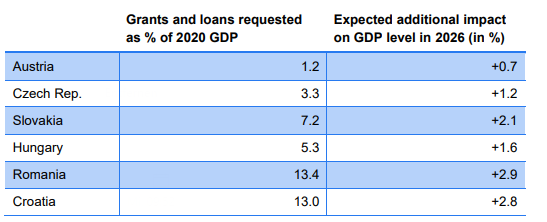
Even though Covid infection figures are rising again due to the Delta variant, higher vaccination rates provide grounds for optimism regarding the ongoing economic recovery. The economy in Europe is growing again, with the EU Recovery Fund providing additional fuel for positive forecasts.
“The economies in Central and Eastern Europe have done well during the crisis. The indicators are now clearly pointing to an economic recovery that is even more dynamic in the eastern part of the EU than in Western Europe. I’m convinced that the EU Recovery Fund will provide an additional impulse for growth in the coming years,” says Bernd Spalt, CEO of Erste Group. “Of course, it remains to be seen how the Covid pandemic will develop.”
HIGH RESILIENCE LEADS TO IMPROVED FORECASTS
Erste Group's core markets proved their resilience during the crisis year 2020. The economies of Central and Eastern Europe (CEE) and Austria proved resilient to impact of Covid-related restrictions also during the first quarter of 2021. Although lockdowns weighed on the services and retail sectors, the manufacturing sector – which traditionally plays a key role in the CEE region – was generally much less affected. The confidence placed in the region is also reflected in performance of its stock markets: during the first half of the year, the market capitalization of the leading CEE indices rose by 17.6% on a weighted average basis.
During the second quarter of this year, Erste Group raised its forecasts for full-year GDP growth for all its markets. The banking group’s macro research specialists now expect most of the economies in the CEE region to post growth above the eurozone average (+4.4%) in 2021.

EU RECOVERY FUND TO PROVIDE ADDITIONAL DYNAMIC FOR UPSWING
The economic stimulus packages of the EU Recovery Fund promise to provide additional momentum to the ongoing upswing by significantly boosting growth, especially from 2022 onwards. These packages involve payments to the CEE countries amounting to between 3.3% (Czech Republic) and 13.4% (Romania) of the countries’ GDP levels in 2020.
Clear growth expectations are attached to the application of these funds: current estimates suggest that the grants that the EU Recovery Fund will provide CEE economies can provide an additional boost to their GDP levels in 2026 of between 1.2% (Czech Republic) and 2.9% (Romania). Because the EU member states are implementing their EU Recovery Fund plans at the same time, the cross-border “spillover effects” provide an additional contribution to the funds’ overall positive effect on GDP levels or may actually even account for a significant part of that effect.

Source: European Commission, Erste Group Research
https://ec.europa.eu/info/sites/default/files/economy-finance/dp144_en.pdf
STRUCTURAL REFORMS GIVE CAUSE FOR ADDITIONAL OPTIMISM
These forecasts do not yet take into account the additional positive contributions to long-term economic performance that potential structural reforms, especially in the areas of sustainability and digitalization, can provide. Parts of the EU Recovery Fund resources are explicitly linked to conditions and milestones in these areas.
The coming years will generally see increased investment in digitization and sustainability. The large volumes of funding earmarked for both of these areas are thus likely to experience strong and sustained demand, triggering additional private investment and co-financing at the corporate level. In addition, structural reforms offer hope for increased competitiveness and productivity, giving the region’s economies a chance to move up the value-added ladder.
ERSTE GROUP’S OUTLOOK FOR 2021: CREDIT GROWTH AND HIGHER EARNINGS
The positive outlook for the region’s macroeconomic environment gives Erste Group grounds for optimism. The banking group expects risk costs for the full year to not exceed 30bp, sees its net loan growth rate in the mid-single digits, and expects its operating income to continue rising. Despite negative interest rates in the euro zone, the bank expects a slight increase in net interest income, and the second important revenue component, net fee and commission income, is expected to increase in the high single digits. Positive impulses should continue to come from fund management, the securities business, insurance brokerage and the ongoing recovery in the payments business.
“The recovery in our region and the strength of our business model make me confident that we will be able to achieve a net profit for the full year 2021 that is significantly above the level of 2020,” says Erste Group Chief Executive Bernd Spalt.
A continuation or further tightening of the governmental measures implemented to address the impact of the Covid-19 pandemic, as well as potential – and currently unquantifiable - political, regulatory and economic risks could make it more difficult to achieve this target.